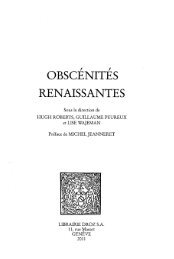Download (3398Kb) - ePrints Soton - University of Southampton
Download (3398Kb) - ePrints Soton - University of Southampton
Download (3398Kb) - ePrints Soton - University of Southampton
You also want an ePaper? Increase the reach of your titles
YUMPU automatically turns print PDFs into web optimized ePapers that Google loves.
al., 1983; MacDonald and Thopmson, 1985a, b; Barber et al., 1988; Paulet and<br />
Boucher, 1991; Honkoop and van der Meer, 1997), gastropods (Spight and Emlen,<br />
1976; Chester, 1996; Cheung and Lam, 1999;), opisthobranchs (Krug, 1998),<br />
echinoids (Vadas, 1977; Meidel and Scheibling, 1998; Beddingfield and McClintok,<br />
1998; Bertram and Strathmann, 1998; Brewin et al., 2000), Antarctic and temperate<br />
echinoderms (Shilling and Manahan, 1994), holothurians (Wigham et al., 2003) and<br />
asteroids ( George et al., 1990; George, 1994; Bosch and Slattery, 1999; Ramirez-<br />
Llodra et al., 2002).<br />
4.4.2. Depth allocation <strong>of</strong> the species and possible causes.<br />
Howell et al. (2002) found distinct changes in the vertical distribution <strong>of</strong> the<br />
asteroid fauna in the Porcupine Seabight and Porcupine Abyssal Plain. The present<br />
study also found differences in the reproductive traits <strong>of</strong> the species in correspondence<br />
to the zones proposed by Howell et al. (2002) and taking into account the effect <strong>of</strong> the<br />
environmental factors in selecting the species with successful life-history strategies, as<br />
well as the phylogenetic constrains inherent <strong>of</strong> the species.<br />
Predator species are more abundant at shallower depths and become scarce<br />
with increasing depth (Carey, 1972; Howell et al., 2002). Thus the upper slope zone<br />
ranging from the shelf break to ~700 m is characterized by large seasonally<br />
reproducing predators. They produce small eggs correlated with a large population<br />
size, which increases the chances <strong>of</strong> successful fertilization. It is not necessary to<br />
invest energy in producing large eggs because the small eggs produce planktotrophic<br />
larvae which feed directly on primary production from surface waters. This upper<br />
continental slope zone is characterized by asteroid species which exhibit the lifehistory<br />
periodic pattern established by Winemiller and Rose (1992), <strong>of</strong> large body<br />
86
















